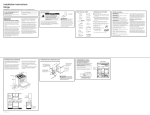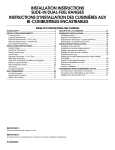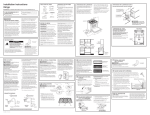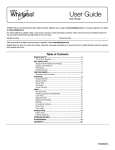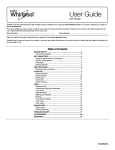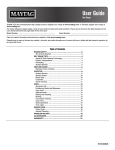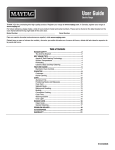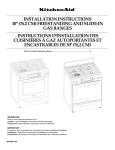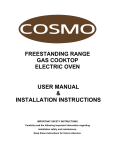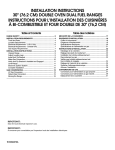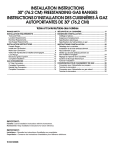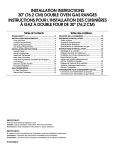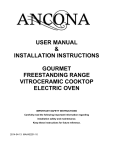Download Whirlpool WEC530H0DS Installation Guide
Transcript
INSTALLATION INSTRUCTIONS 30" (76.0 CM) SLIDE-IN ELECTRIC RANGES INSTRUCTIONS D’INSTALLATION DES CUISINIÈRES ÉLECTRIQUES ENCASTRABLES DE 30" (76,0 CM) Table of Contents/Table des matières RANGE SAFETY .............................................................................2 INSTALLATION REQUIREMENTS ................................................3 Tools and Parts ............................................................................3 Location Requirements................................................................3 Electrical Requirements - U.S.A. Only .........................................6 Electrical Requirements - Canada Only.......................................7 INSTALLATION INSTRUCTIONS ..................................................8 Unpack Range..............................................................................8 Install Anti-Tip Bracket.................................................................8 Adjust Leveling Legs ....................................................................9 Level Range................................................................................10 Electrical Connection - U.S.A. Only...........................................10 Verify Anti-Tip Bracket is Installed and Engaged ......................15 Remove/Replace Drawer ...........................................................16 Oven Door ..................................................................................16 Complete Installation .................................................................17 SÉCURITÉ DE LA CUISINIÈRE ...................................................19 EXIGENCES D’INSTALLATION ...................................................20 Outillage et pièces......................................................................20 Exigences d’emplacement.........................................................20 Spécifications électriques – Canada seulement........................23 INSTRUCTIONS D’INSTALLATION.............................................24 Déballage de la cuisinière ..........................................................24 Installation de la bride antibasculement ....................................24 Réglage des pieds de nivellement .............................................25 Réglage de l’aplomb de la cuisinière .........................................26 Vérifier que la bride antibasculement est bien installée et engagée......................................................26 Dépose et repose du tiroir..........................................................27 Porte du four...............................................................................27 Achever l’installation ..................................................................28 IMPORTANT: Save for local electrical inspector's use. IMPORTANT : À conserver pour consultation par l'inspecteur local des installations électriques. W10665255A RANGE SAFETY Your safety and the safety of others are very important. We have provided many important safety messages in this manual and on your appliance. Always read and obey all safety messages. This is the safety alert symbol. This symbol alerts you to potential hazards that can kill or hurt you and others. All safety messages will follow the safety alert symbol and either the word “DANGER” or “WARNING.” These words mean: DANGER WARNING You can be killed or seriously injured if you don't immediately follow instructions. You can be killed or seriously injured if you don't follow instructions. All safety messages will tell you what the potential hazard is, tell you how to reduce the chance of injury, and tell you what can happen if the instructions are not followed. WARNING Tip Over Hazard A child or adult can tip the range and be killed. Install anti-tip bracket to floor or wall per installation instructions. Slide range back so rear range foot is engaged in the slot of the anti-tip bracket. Re-engage anti-tip bracket if range is moved. Do not operate range without anti-tip bracket installed and engaged. Failure to follow these instructions can result in death or serious burns to children and adults. To verify the anti-tip bracket is installed and engaged: Anti-Tip Bracket • Slide range forward. • Look for the anti-tip bracket securely attached to floor or wall. • Slide range back so rear range foot is under anti-tip bracket. Range Foot 2 • See installation instructions for details. INSTALLATION REQUIREMENTS Optional Parts Tools and Parts Gather the required tools and parts before starting installation. Read and follow the instructions provided with any tools listed here. Tools needed ■ Tape measure ■ Masking tape ■ Flat-blade screwdriver ■ ¼" (13 mm) drive ratchet ■ Phillips screwdriver ■ ¼" (13 mm) nut driver ■ Level ■ ■ Hand or electric drill ³⁄₈" (10 mm) and ⁵⁄₁₆" (8 mm) nut driver ■ Wrench or pliers ■ ¹⁄₈" (3 mm) drill bit (for wood floors) ■ Marker or pencil ■ Tin snips or large wire cutters (for cutting ground strap if necessary) Parts supplied Check that all parts are included. ■ 3 - 10-32 hex nuts (attached to terminal block) ■ 3 - Direct wire lugs ■ 2 - #10 x 1⁵⁄₈" (4.1 cm) screws (for mounting anti-tip bracket) ■ Anti-tip bracket (inside oven cavity) Anti-tip bracket must be securely mounted to the back wall or floor. Thickness of flooring may require longer screws to anchor bracket to subfloor. Longer screws are available from your local hardware store. ■ ■ IEL730C WEC530H0D WEE730H0D YIEL730C YWEE730H0D JES1450CD JES1450D JIS1450CD JIS1450D KSEG700E KSEB900E KSIB900E MES8880D WEE760H0D YKSEG700E YKSEB900E YKSIB900E YMES8880D YWEE760H0D 2 3 Parts needed If using a power supply cord kit: ■ A UL listed power supply cord kit marked for use with ranges. The cord should be rated at 250 volts minimum, 40 amps or 50 amps that is marked for use with nominal 1³⁄₈" (3.5 cm) diameter connection opening and must end in ring terminals or open-end spade terminals with upturned ends. Backsplash Kits: High 6" (15.2 cm) White - Order Part Number W10655448 High 6" (15.2 cm) Black - Order Part Number W10655449 High 6" (15.2 cm) Stainless Steel - Order Part Number W10655450 Location Requirements IMPORTANT: Observe all governing codes and ordinances. ■ It is the installer’s responsibility to comply with installation clearances specified on the model/serial rating plate. The model/serial rating plate is located behind the oven door on the top right-hand side of the oven frame. ■ The range should be located for convenient use in the kitchen. ■ Recessed installations must provide complete enclosure of the sides and rear of the range. ■ To eliminate the risk of burns or fire by reaching over heated surface units, cabinet storage space located above the surface units should be avoided. If cabinet storage is to be provided, the risk can be reduced by installing a range hood or microwave hood combination that projects horizontally a minimum of 5" (12.7 cm) beyond the bottom of the cabinets. ■ All openings in the wall or floor where range is to be installed must be sealed. ■ Cabinet opening dimensions that are shown must be used. Given dimensions are minimum clearances. ■ The anti-tip bracket must be installed. To install the anti-tip bracket shipped with the range, see “Install Anti-Tip Bracket” section. ■ Grounded electrical supply is required. See the appropriate “Electrical Requirements” section. ■ Contact a qualified floor covering installer to check that the floor covering can withstand at least 200°F (93°C). ■ Use an insulated pad or ¼" (0.64 cm) plywood under range if installing range over carpeting. For model: Oven racks ■ To purchase these or any other accessories, please reference the “Accessories” section of the User Guide for contact information. ■ Side Trim Kits: White - Order Part Number W10677527 Black - Order Part Number W10675026 Stainless Steel - Order Part Number W10675028 IMPORTANT: To avoid damage to your cabinets, check with your builder or cabinet supplier to make sure that the materials used will not discolor, delaminate or sustain other damage. This oven has been designed in accordance with the requirements of UL and CSA International and complies with the maximum allowable wood cabinet temperatures of 194°F (90°C). A UL listed strain relief. Check local codes. Check existing electrical supply. See the appropriate “Electrical Requirements” section. It is recommended that all electrical connections be made by a licensed, qualified electrical installer. 3 Mobile Home - Additional Installation Requirements The installation of this range must conform to the Manufactured Home Construction and Safety Standard, Title 24 CFR, Part 3280 (formerly the Federal Standard for Mobile Home Construction and Safety, Title 24, HUD Part 280). When such standard is not applicable, use the Standard for Manufactured Home Installations, ANSI A225.1/NFPA 501A or with local codes. In Canada, the installation of this range must conform with the current standards CAN/CSA-A240-latest edition, or with local codes. Mobile home installations require: ■ When this range is installed in a mobile home, it must be secured to the floor during transit. Any method of securing the range is adequate as long as it conforms to the standards listed above. ■ Product Dimensions This manual covers several models. Your model may appear different from the models depicted. Dimensions given are maximum dimensions across all models. Model KSEB900 B C A Four-wire power supply cord or cable must be used in a mobile home installation. The appliance wiring will need to be revised. See “Electrical Connection - U.S.A. Only” section. D E F A. 1³⁄₁₆" (3.0 cm) height from cooktop to top of vent B. 29⁷⁄₈" (75.9 cm) C. Model/serial number plate (located behind the oven door on the top right-hand side of the oven frame) D. 36" (91.4 cm) height to top of cooktop edge with leveling legs screwed all the way in* E. 28⁵⁄₁₆" (71.9 cm) max. depth from front of console to back of range. F. 28⁷⁄₈" (73.3 cm) max. depth from handle to back of range. IMPORTANT: Range must be level after installation. Follow the instructions in the “Level Range” section. Using the cooktop as a reference for leveling the range is not recommended. *Range can be raised approximately 1" (2.5 cm) by adjusting the leveling legs. 4 Cabinet Dimensions Cabinet opening dimensions shown are for 25" (64.0 cm) countertop depth, 24" (61.0 cm) base cabinet depth and 36" (91.4 cm) countertop height. IMPORTANT: If installing a range hood or microwave hood combination above the range, follow the range hood or microwave hood combination installation instructions for dimensional clearances above the cooktop surface. Range may be installed next to combustible walls with zero clearance. NOTE: When installed in a slide-in cutout, the front of oven door may protrude beyond the base cabinet. Slide-in Cutout Freestanding cutout D B D B C C L A A E E K K G G H I F H I F J I A. 18" (45.7 cm) upper side cabinet to countertop B. 13" (33 cm) max. upper cabinet depth C. 30" (76.2 cm) min. opening width D. For minimum clearance to top of cooktop, see NOTE*. E. In U.S.A.: 30" (76.2 cm) min. opening width In Canada: 31" (78.7 cm) min. opening width F. The shaded area is recommended for installation of grounded outlet. G. 13¹⁄₈" (33.3 cm) H. 7¹¹⁄₁₆" (19.5 cm) I. 4¹³⁄₁₆" (12.2 cm) J. 3¹¹⁄₁₆" (9.4 cm) or measurement of L, whichever is greater K. Cabinet door or hinges should not extend into the cutout. L. Remaining counter depth should not exceed 2¼" (5.7 cm) J I A. 18" (45.7 cm) upper side cabinet to countertop B. 13" (33 cm) max. upper cabinet depth C. 30" (76.2 cm) min. opening width D. For minimum clearance to top of cooktop, see NOTE*. E. In U.S.A.: 30" (76.2 cm) min. opening width In Canada: 31" (78.7 cm) min. opening width F. The shaded area is recommended for installation of grounded outlet. G. 13¹⁄₈" (33.3 cm) H. 7¹¹⁄₁₆" (19.5 cm) I. 4¹³⁄₁₆" (12.2 cm) J. 3¹¹⁄₁₆" (9.4 cm) K. Cabinet door or hinges should not extend into the cutout. *NOTE: 24" (61.0 cm) minimum when bottom of wood or metal cabinet is shielded by not less than ¹⁄₄" (0.64 cm) flame retardant millboard covered with not less than No. 28 MSG sheet steel, 0.015" (0.4 mm) stainless steel, 0.024" (0.6 mm) aluminum or 0.020" (0.5 mm) copper. 30" (76.2 cm) minimum clearance between the top of the cooking platform and the bottom of an uncovered wood or metal cabinet. 5 Electrical Requirements - U.S.A. Only If codes permit and a separate ground wire is used, it is recommended that a qualified electrical installer determine that the ground path and wire gauge are in accordance with local codes. Do not use an extension cord. Be sure that the electrical connection and wire size are adequate and in conformance with the National Electrical Code, ANSI/ NFPA 70-latest edition and all local codes and ordinances. A copy of the above code standards can be obtained from: National Fire Protection Association 1 Batterymarch Park Quincy, MA 02169-7471 WARNING: Improper connection of the equipment-grounding conductor can result in a risk of electric shock. Check with a qualified electrician or service technician if you are in doubt as to whether the appliance is properly grounded. Do not modify the power supply cord plug. If it will not fit the outlet, have a proper outlet installed by a qualified electrician. Electrical Connection To properly install your range, you must determine the type of electrical connection you will be using and follow the instructions provided for it here. ■ Range must be connected to the proper electrical voltage and frequency as specified on the model/serial number rating plate. The model/serial rating plate is located behind the oven door on the top right-hand side of the oven frame. ■ This range is manufactured with the neutral terminal connected to the cabinet. Use a 3-wire, UL listed, 40- or 50-amp power supply cord (pigtail) (see the following Range Rating chart). If local codes do not permit ground through the neutral, use a 4-wire power supply cord rated at 250 volts, 40- or 50-amps and investigated for use with ranges. Range Rating* Specified Rating of Power Supply Cord Kit and Circuit Protection 120/240 Volts 120/208 Volts Amps 8.8 - 16.5 KW 16.6 - 22.5 KW 7.8 - 12.5 KW 12.6 - 18.5 KW 40 or 50** 50 If connecting to a 3-wire system: Local codes may permit the use of a UL listed, 3-wire, 250-volt, 40- or 50-amp range power supply cord (pigtail). This cord contains 3 copper conductors with ring terminals or open-end spade terminals with upturned ends, terminating in a NEMA Type 10-50P plug on the supply end. Connectors on the appliance end must be provided at the point the power supply cord enters the appliance. This uses a 3-wire receptacle of NEMA Type 10-50R. 3-wire receptacle (10-50R) If connecting to a 4-wire system: This range is manufactured with the ground connected to the neutral by a link. The ground must be revised so the green ground wire of the 4-wire power supply cord is connected to the cabinet. See “Electrical Connection - U.S.A. Only” section. Grounding through the neutral conductor is prohibited for new branch-circuit installations (1996 NEC); mobile homes; and recreational vehicles, or an area where local codes prohibit grounding through the neutral conductor. When a 4-wire receptacle of NEMA Type 14-50R is used, a matching UL listed, 4-wire, 250-volt, 40- or 50-amp, range power supply cord (pigtail) must be used. This cord contains 4 copper conductors with ring terminals or open-end spade terminals with upturned ends, terminating in a NEMA Type 14-50P plug on the supply end. The fourth (grounding) conductor must be identified by a green or green/yellow cover and the neutral conductor by a white cover. Cord should be Type SRD or SRDT with a UL listed strain relief and be at least 4 ft (1.22 m) long. 4-wire receptacle (14-50R) *The NEC calculated load is less than the total connected load listed on the model/serial rating plate. **If connecting to a 50-amp circuit, use a 50-amp rated cord with kit. For 50-amp rated cord kits, use kits that specify use with a nominal 1³⁄₈" (34.9 mm) diameter connection opening. ■ A circuit breaker is recommended. ■ The range can be connected directly to the circuit breaker box (or fused disconnect) through flexible or nonmetallic sheathed, copper or aluminum cable. See the “Electrical Connection - U.S.A. Only” section. ■ Allow 2 to 3 ft (61.0 cm to 91.4 cm) of slack in the line so that the range can be moved if servicing is ever necessary. ■ A UL listed conduit connector must be provided at each end of the power supply cable (at the range and at the junction box). ■ Wire sizes and connections must conform with the rating of the range. ■ The tech sheet and wiring diagram are located on the back of the range in a plastic bag. 6 The minimum conductor sized for the copper 4-wire power cord are: 40-amp circuit 2 No.-8 conductors 1 No.-10 white neutral 1 No.-10 green grounding Electrical Requirements - Canada Only WARNING ■ Check with a qualified electrical installer if you are not sure the range is properly grounded. Range Rating* Electrical Shock Hazard Electrically ground range. Failure to do so can result in death, fire, or electrical shock. If codes permit and a separate ground wire is used, it is recommended that a qualified electrical installer determine that the ground path is adequate and wire gauge are in accordance with local codes. Be sure that the electrical connection and wire size are adequate and in conformance with CSA Standard C22.1, Canadian Electrical Code, Part 1 - latest edition, and all local codes and ordinances. A copy of the above code standards can be obtained from: Canadian Standards Association 178 Rexdale Blvd. Toronto, ON M9W 1R3 CANADA Specified Rating of Power Supply Cord Kit and Circuit Protection 120/240 Volts 120/208 Volts Amps 8.8 - 16.5 KW 16.6 - 22.5 KW 7.8 - 12.5 KW 12.6 - 18.5 KW 40 or 50** 50 *The NEC calculated load is less than the total connected load listed on the model/serial rating plate. **If connecting to a 50-amp circuit, use a 50-amp rated cord with kit. For 50-amp rated cord kits, use kits that specify use with a nominal 1³⁄₈" (34.9 mm) diameter connection opening. ■ A circuit breaker is recommended. ■ This range is equipped with a CSA International Certified Power Cord intended to be plugged into a standard 14-50R wall receptacle. Be sure the wall receptacle is within reach of range’s final location. ■ Do not use an extension cord. ■ The tech sheet and wiring diagram are located on the back of the range in a plastic bag. 7 INSTALLATION INSTRUCTIONS Unpack Range WARNING Install Anti-Tip Bracket WARNING Excessive Weight Hazard Use two or more people to move and install range. Failure to do so can result in back or other injury. 1. Remove shipping materials, tape and film from the range. Keep cardboard bottom under range. Do not dispose of anything until the installation is complete. 2. Remove oven racks and parts package from oven and shipping materials. 3. To remove cardboard bottom, first take 4 cardboard corners from the carton. Stack one cardboard corner on top of another. Repeat with the other 2 corners. Place them lengthwise on the floor behind the range to support the range when it is laid on its back. 4. Using 2 or more people, firmly grasp the range and gently lay it on its back on the cardboard corners. 5. Remove cardboard bottom. The leveling legs can be adjusted while the range is on its back. See the “Adjust Leveling Legs” section. NOTE: To place range back up into a standing position, put a sheet of cardboard or hardboard on the floor in front of range to protect the flooring. Using 2 or more people, stand range back up onto the cardboard or hardboard. Tip Over Hazard A child or adult can tip the range and be killed. Install anti-tip bracket to floor or wall per installation instructions. Slide range back so rear range foot is engaged in the slot of the anti-tip bracket. Re-engage anti-tip bracket if range is moved. Do not operate range without anti-tip bracket installed and engaged. Failure to follow these instructions can result in death or serious burns to children and adults. 1. Remove the anti-tip bracket from the inside of the oven. 2. Determine which mounting method to use: floor or wall. If you have a stone or masonry floor, you can use the wall mounting method. If you are installing the range in a mobile home, you must secure the range to the floor. This anti-tip bracket and screws can be used with wood or metal studs. 3. Determine and mark centerline of the cutout space. The mounting can be installed on either the left side or right side of the cutout. Position mounting bracket against the wall in the cutout so that the V-notch of the bracket is 12½" (31.8 cm) from centerline as shown. B Centerline A A. 12½" (31.8 cm) B. Bracket V-notch 8 4. Drill two ¹⁄₈" (3 mm) holes that correspond to the bracket holes of the determined mounting method. See the following illustrations. Floor Mounting Adjust Leveling Legs 1. If range height adjustment is necessary, use a wrench or pliers to loosen the 4 leveling legs. This may be done with the range on its back or with the range supported on 2 legs after the range has been placed back to a standing position. NOTE: To place range back up into a standing position, put a sheet of cardboard or hardboard in front of range. Using 2 or more people, stand range back up onto the cardboard or hardboard. WARNING Rear position Front position Diagonal (2 options) Wall Mounting Tip Over Hazard A child or adult can tip the range and be killed. Install anti-tip bracket to floor or wall per installation instructions. 5. Using the Phillips screwdriver, mount anti-tip bracket to the wall or floor with the two #10 x 1⁵⁄₈" (4.1 cm) screws provided. 6. Move range close enough to opening to allow for final electrical connections. Remove shipping base, cardboard or hardboard from under range. 7. Move range into its final location, making sure rear leveling leg slides into anti-tip bracket. 8. Move range forward onto shipping base, cardboard or hardboard to continue installing the range using the following installation instructions. Slide range back so rear range foot is engaged in the slot of the anti-tip bracket. Re-engage anti-tip bracket if range is moved. Do not operate range without anti-tip bracket installed and engaged. Failure to follow these instructions can result in death or serious burns to children and adults. 2. Measure the distance from the top of the counter to the floor. 3. Measure the distance from the top of the cooktop to the bottom of the leveling legs. This distance should be the same. If it is not, adjust the leveling legs to the correct height. The leveling legs can be loosened to add up to a maximum of 1" (2.5 cm). A minimum of ³⁄₁₆" (5 mm) is needed to engage the anti-tip bracket. NOTE: If height adjustment is made when range is standing, tilt the range back to adjust the front legs, then tilt forward to adjust the rear legs. 4. When the range is at the correct height, check that there is adequate clearance under the range for the anti-tip bracket. Before sliding range into its final location, check that the antitip bracket will slide under the range and onto the rear leveling leg prior to anti-tip bracket installation. NOTE: If a Trim Kit will be used, the top of the cooktop should be higher than the counter. See the Installation Instructions included with the Trim Kit for the correct height. 9 3. Remove plastic tag holding three 10-32 hex nuts from the middle post of the terminal block. Level Range 1. Place level on the oven bottom as indicated in one of the two figures below depending on the size of the level. Check with the level side to side and front to back. 2. If range is not level, use a wrench or pliers to adjust leveling legs up or down until the range is level. NOTE: Range must be level for satisfactory baking performance and best cleaning results using AquaLift® Self-Clean Technology. 4. Assemble a UL listed strain relief in the opening. Electrical Connection - U.S.A. Only If your home has a 3- or 4-wire receptacle, continue with “Install Using a Power Supply Cord.” If your home has a 3- or 4-wire direct connection, go to “Install Using Direct Wire.” Install Using a Power Supply Cord A WARNING A. UL listed strain relief 5. Complete installation following instructions for your type of electrical connection: 4-wire (recommended) 3-wire (if 4-wire is not available) Electrical Shock Hazard Electrical Connection Options Disconnect power before servicing. Use a new 40 amp power supply cord. Plug into a grounded outlet. Failure to follow these instructions can result in death, fire, or electrical shock. Power supply cord strain relief 1. Disconnect power. 2. Remove the lower access cover screws located on the back of the range. Pull the bottom of the cover toward you and out to remove cover from range. A B C A. Three mounting tabs B. Lower access cover C. Screws (2) 10 If your home has: And you will be connecting to: Go to Section: 3-wire receptacle (NEMA type 10-50R) A UL listed, 250-volt minimum, 40- or 50-amp, range power supply cord 3-wire connection: Power supply cord 4-wire receptacle (NEMA type 14-50R) A UL listed, 250-volt minimum, 40- or 50-amp, range power supply cord 4-wire connection: Power supply cord 3-wire connection: Power Supply Cord 4-wire connection: Power Supply Cord Use this method only if local codes permit connecting chassis ground conductor to neutral wire of power supply cord. 1. Feed the power supply cord through the strain relief on the cord/conduit plate on bottom of range. Allow enough slack to easily attach the wiring to the terminal block. A Use this method for: ■ New branch-circuit installations (1996 NEC) ■ Mobile homes ■ Recreational vehicles ■ In an area where local codes prohibit grounding through the neutral 1. Part of metal ground strap must be cut out and removed. B A B C C A. Metal ground strap B. Discard C. Ground-link screw D A. Terminal block B. Ground-link screw C. UL listed strain relief D. Power supply cord wires - large opening 2. Use ³⁄₈" nut driver to connect the neutral (white) wire to the center terminal block post with one of the 10–32 hex nuts. 2. Use a Phillips screwdriver to remove the ground-link screw from the back of the range. Save the ground-link screw and the end of the ground link under the screw. 3. Feed the power supply cord through the strain relief on the cord/conduit plate on bottom of range. Allow enough slack to easily attach the wiring to the terminal block. A B A E C D B D C A. 10–32 hex nut B. Line 2 (red) C. Ground-link screw D. Neutral (white) wire E. Line 1 (black) 3. Connect line 2 (red) and line 1 (black) wires to the outer terminal block posts with 10-32 hex nuts. 4. Firmly tighten hex nuts. NOTE: For power supply cord replacement, use only a power cord rated at 250 volts minimum, 40- or 50-amps that is marked for use with nominal 1³⁄₈" (3.5 cm) diameter connection opening, with ring terminals and marked for use with ranges. A. Terminal block B. Ground-link screw C. UL listed strain relief D. Power supply cord wires 4. Use a Phillips screwdriver to connect the green ground wire from the power supply cord to the range with the ground-link screw and ground-link section. The ground wire must be attached over the ground-link section. 5. Tighten strain relief screws. IMPORTANT: Verify the tightness of the hex nuts. 6. Replace lower access cover. 11 5. Use ³⁄₈" nut driver to connect the neutral (white) wire to the center terminal block post with one of the 10–32 hex nuts. A 2. Remove the lower access cover screws located on the back of the range. Pull the bottom of the cover toward you and out to remove cover from range. F A B B E C C D A. 10–32 hex nut B. Ground-link screw C. Line 2 (red) D. Green ground wire E. Neutral (center) wire F. Line 1 (black) 6. Connect line 2 (red) and line 1 (black) wires to the outer terminal block posts with 10-32 hex nuts. 7. Firmly tighten hex nuts. NOTE: For power supply cord replacement, use only a power cord rated at 250 volts minimum, 40- or 50-amps that is marked for use with nominal 1³⁄₈" (3.5 cm) diameter connection opening, with ring terminals and marked for use with ranges. A. Three mounting tabs B. Lower access cover C. Screws (2) 3. Remove plastic tag holding three 10-32 hex nuts from the middle post of the terminal block. 8. Tighten strain relief screws. IMPORTANT: Verify the tightness of the hex nuts. 9. Replace lower access cover. Install Using Direct Wire WARNING 4. Assemble a UL listed conduit connector in the opening. A Electrical Shock Hazard Disconnect power before servicing. B Use 8 gauge copper or 6 gauge aluminum wire. Electrically ground range. Failure to follow these instructions can result in death, fire, or electrical shock. Direct wire strain relief 1. Disconnect power. 12 A. Removable retaining nut B. Conduit 5. Tighten strain relief screw against the flexible conduit. Direct Wire Installation: Copper or Aluminum Wire This range may be connected directly to the fuse disconnect or circuit breaker box. Depending on your electrical supply, make the required 3-wire or 4-wire connection. 1. Strip outer covering back 3" (7.6 cm) to expose wires. Strip the insulation back ³⁄₈" (1.0 cm) from the end of each wire. 3-wire connection: Direct Wire Use this method only if local codes permit connecting ground conductor to neutral supply wire. 1. Pull the wires through the conduit on cord/conduit plate on bottom of range. Allow enough slack to easily attach the wiring to the terminal block. ³⁄₈" (1.0 cm) A B 3" (7.6 cm) 2. Allow enough slack in the wire to easily attach the wiring terminal block. 3. Complete installation following instructions for your type of electrical connection: 4-wire (recommended) C F 3-wire (if 4-wire is not available) Electrical Connection Options D If your home has: And you will be connecting to: Go to Section: 3-wire direct A circuit breaker box or fused disconnect 3-wire connection: Direct wire A circuit breaker box or fused disconnect 4-wire connection: Direct wire ³⁄₈" (1.0 cm) 3" (7.6 cm) 4-wire direct ³⁄₈" (1.0 cm) E D. Line 2 (red) wire E. Bare (green) ground wire F. Line 1 (black) wire A. Terminal block B. Ground-link screw C. Cord/conduit plate 2. Attach terminal lugs to line 2 (red), bare (green) ground, and line 1 (black) wires. Loosen (do not remove) the setscrew on the front of the terminal lug and insert exposed wire end through bottom of terminal lugs. Securely tighten setscrew to torque as shown in the following Bare Wire Torque Specifications chart. A 5" (12.7 cm) B C D E A. Terminal lug B. Setscrew C. Line 2 (red) wire D. Bare (green) ground wire E. Line 1 (black) wire 13 Bare Wire Torque Specifications 4-wire Connection: Direct Wire Attaching terminal lugs to the terminal block - 20 lbs-in. (2.3 N-m) Wire Awg Torque 8 gauge copper 25 lbs-in. (2.8 N-m) Use this method for: ■ New branch-circuit installations (1996 NEC) 6 gauge aluminum 35 lbs-in. (4.0 N-m) ■ Mobile homes ■ Recreational vehicles ■ In an area where local codes prohibit grounding through the neutral 3. Use ³⁄₈" nut driver to connect the bare (green) ground wire to the center terminal block post with one of the 10–32 hex nuts. 1. Part of metal ground strap must be cut out and removed. F A E A B C B A. Metal ground strap B. Discard C. Ground-link screw D C A. 10–32 hex nut B. Line 2 (red) C. Ground-link screw D. Bare (green) ground wire E. Line 1 (black) F. Terminal lug 4. Connect line 2 (red) and line 1 (black) wires to the outer terminal block posts with 10-32 hex nuts. 5. Firmly tighten hex nuts. IMPORTANT: Verify the tightness of the hex nuts. 6. Replace lower access cover. 2. Use a Phillips screwdriver to remove the ground-link screw from the back of the range. Save the ground-link screw and the end of the ground link under the screw. 3. Pull the wires through the strain relief on bottom of range. Allow enough slack to easily attach wiring to the terminal block. A B C G D E F A. Terminal block B. Ground-link screw C. Cord/conduit plate D. Bare (green) ground wire 14 E. Line 2 (red) wire F. Neutral (white) wire G. Line 1 (black) wire 4. Attach terminal lugs to line 1 (black), neutral (white), and line 2 (red) wires. Loosen (do not remove) the setscrew on the front of the terminal lug and insert exposed wire end through bottom of terminal lugs. Securely tighten setscrew to torque as shown in the following Bare Wire Torque Specifications chart. A B C D E Verify Anti-Tip Bracket is Installed and Engaged On Ranges Equipped with a Premium Storage Drawer: 1. Slide range into final location, making sure rear leveling leg slides into anti-tip bracket. 2. Remove the premium storage drawer. See the “Remove/ Replace Drawer” section. 3. Use a flashlight to look underneath the bottom of the range. 4. Visually check that the rear range foot is inserted into the slot of the anti-tip bracket. On Ranges Equipped with a Warming Drawer or Baking Drawer: 1. Slide range into final location, making sure rear leveling leg slides into anti-tip bracket. Leave a 1" (2.5 cm) gap between the back of the range and the back wall. 2. Place the outside of your foot against the bottom front of the warming drawer or baking drawer to keep the range from moving, and grasp the back of the range as shown. A. Terminal lug B. Setscrew C. Line 2 (red) wire D. Neutral (white) wire E. Line 1 (black) wire Bare Wire Torque Specifications Attaching terminal lugs to the terminal block - 20 lbs-in. (2.3 N-m) Wire Awg Torque 8 gauge copper 25 lbs-in. (2.8 N-m) 6 gauge aluminum 35 lbs-in. (4.0 N-m) 5. Use a hex or Phillips screwdriver to connect the bare (green) ground wire to the range with the ground-link screw and ground-link section. The ground wire must be attached over the ground-link section and must not contact any other terminal. 6. Use ³⁄₈" nut driver to connect the neutral (white) wire to the center terminal block post with one of the 10–32 hex nuts. G A B F D C A. 10–32 hex nut B. Line 2 (red) C. Bare (green) ground wire D. Ground-link screw E E. Neutral (white) wire F. Line 1 (black) G. Terminal lug 7. Connect line 2 (red) and line 1 (black) wires to the outer terminal block posts with 10-32 hex nuts. 8. Firmly tighten hex nuts. IMPORTANT: Verify the tightness of the hex nuts. 9. Replace lower access cover. 3. Slowly attempt to tilt the range forward. If you encounter immediate resistance, the range foot is engaged in the anti-tip bracket. Go to Step 8. 4. If the rear of the range lifts more than ½" (1.3 cm) off the floor without resistance, stop tilting the range and lower it gently back to the floor. The range foot is not engaged in the anti-tip bracket. IMPORTANT: If there is a snapping or popping sound when lifting the range, the range may not be fully engaged in the bracket. Check to see if there are obstructions keeping the range from sliding to the wall or keeping the range foot from sliding into the bracket. Verify that the bracket is held securely in place by the mounting screws. 5. Slide the range forward, and verify that the anti-tip bracket is securely attached to the floor or wall. 6. Slide range back so the rear range foot is inserted into the slot of the anti-tip bracket. 7. Repeat steps 1 and 2 to ensure that the range foot is engaged in the anti-tip bracket. If the rear of the range lifts more than ½" (1.3 cm) off the floor without resistance, the anti-tip bracket may not be installed correctly. Do not operate the range without anti-tip bracket installed and engaged. Please reference the “Warranty” section of the User Guide to contact service. 8. Move the range into its final location. Check that the range is level by placing a level on the oven bottom. See the “Level Range” section. IMPORTANT: If the range is moved to adjust the leveling legs, verify that the anti-tip bracket is engaged by repeating steps 1-8. 15 Remove/Replace Drawer Oven Door (on some models) For normal range use, it is not suggested to remove the oven door. However, if removal is necessary, make sure the oven is off and cool. Then, follow these instructions. The oven door is heavy. Remove all items from inside the baking drawer, warming drawer or premium storage drawer, and allow the range to cool completely before attempting to remove the drawer. To Remove: 1. Open the drawer to its fully open position. 2. Using a flat-blade screwdriver, gently loosen the warming drawer or premium storage drawer from the glide alignment notch and lift up the drawer alignment tab from the glide. To Remove: 1. Open oven door all the way. 2. Pinch the hinge latch between two fingers and pull forward. Repeat on other side of oven door. A A B A. Hinge latch 3. Close the oven door as far as it will shut. 4. Lift the oven door while holding both sides. Continue to push the oven door closed and pull it away from the oven door frame. C A. Flat-blade screwdriver B. Drawer alignment tab C. Drawer glide notch 3. Repeat Step 2 on the other side. The drawer is no longer attached to the drawer glides. Using both hands, pick up the drawer to complete the removal. To Replace: 1. Align the forward drawer notches with the notches in the drawer glides on both sides. Place the rear alignment tabs into the drawer glides on both sides. To Replace: 1. Insert both hanger arms into the door. Be sure that the hinge notches are engaged in the oven door frame. A A A. Hinge notch B A. Drawer alignment tab B. Drawer glide notch 2. Push the drawer in all the way. 3. Gently open and close the drawer to ensure it is seated properly on the glides on both sides. 16 2. Open the oven door. The door should be able to open all the way. 3. Move the hinge levers back to the locked position. Check that the door is free to open and close and is level while closed. If it is not, repeat the removal and installation procedures. Complete Installation 1. Check that all parts are now installed. If there is an extra part, go back through the steps to see which step was skipped. 2. Check that you have all of your tools. 3. Check that you have all of the range accessories, especially oven racks. These accessories may be in the range packaging. 4. Dispose of/recycle all packaging materials. 5. Check that the range is level. See the “Level Range” section. 6. Use a mild solution of liquid household cleaner and warm water to remove waxy residue caused by shipping material. Dry thoroughly with a soft cloth. For more information, see the “Range Care” section of the User Guide. 7. Read the User Guide. 8. Plug power cord into a grounded outlet. Turn power on. 9. Turn on surface elements and oven. See the User Guide for specific instructions on range operation. NOTE: Odors and smoke are normal when the oven is used the first few times. If range does not operate, check the following: ■ Household fuse is intact and tight; or circuit breaker has not tripped. ■ Range is plugged into a grounded outlet. ■ Electrical supply is connected. IMPORTANT: If the range control displays an “F9” or “F9, E0” error code, the electrical outlet in the home may be miswired. Disconnect power and contact a qualified electrician to verify the electrical supply. 10. When the range has been on for 5 minutes, check for heat. If the range is cold, turn off the range and contact a qualified electrician. If you need Assistance or Service: Please reference the “Warranty” section of the User Guide to contact service. 17 Notes 18 SÉCURITÉ DE LA CUISINIÈRE Votre sécurité et celle des autres est très importante. Nous donnons de nombreux messages de sécurité importants dans ce manuel et sur votre appareil ménager. Assurez-vous de toujours lire tous les messages de sécurité et de vous y conformer. Voici le symbole d’alerte de sécurité. Ce symbole d’alerte de sécurité vous signale les dangers potentiels de décès et de blessures graves à vous et à d’autres. Tous les messages de sécurité suivront le symbole d’alerte de sécurité et le mot “DANGER” ou “AVERTISSEMENT”. Ces mots signifient : DANGER AVERTISSEMENT Risque possible de décès ou de blessure grave si vous ne suivez pas immédiatement les instructions. Risque possible de décès ou de blessure grave si vous ne suivez pas les instructions. Tous les messages de sécurité vous diront quel est le danger potentiel et vous disent comment réduire le risque de blessure et ce qui peut se produire en cas de non-respect des instructions. AVERTISSEMENT Risque de basculement Un enfant ou une personne adulte peut faire basculer la cuisinière, ce qui peut causer un décès. Fixer la bride antibasculement au plancher ou au mur, conformément aux instructions d'installation. Faire glisser de nouveau la cuisinière de façon à ce que le pied arrière de la cuisinière se trouve dans la fente de la bride antibasculement. Réengager la bride antibasculement si la cuisinière a été déplacée. Ne pas faire fonctionner la cuisinière si la bride antibasculement n'est pas installée et engagée. Le non-respect de ces instructions peut causer un décès ou des brûlures graves aux enfants et aux adultes. Pour vérifier que la bride antibasculement est bien installée et engagée : Bride • Faire glisser la cuisinière vers l'avant. antibasculement • Vérifier que la bride antibasculement est bien fixée au plancher ou au mur. Pied de la cuisinière • Faire de nouveau glisser la cuisinière vers l'arrière de sorte que le pied de la cuisinière se trouve sous la bride antibasculement. • Voir les instructions d'installation pour plus de détails. 19 EXIGENCES D’INSTALLATION ■ Outillage et pièces Rassembler les outils et pièces nécessaires avant d’entreprendre l’installation. Lire et observer les instructions fournies avec chacun des outils de la liste ci-dessous. Outils nécessaires Un serre-câble (homologation UL). Consulter les codes locaux. Vérifier l’alimentation électrique existante. Voir la section “Spécifications électriques” correspondante. Il est recommandé de faire réaliser tous les raccordements électriques par un électricien qualifié agréé. ■ Mètre-ruban ■ Ruban adhésif de masquage Pièces facultatives ■ Tournevis à lame plate ■ Clé à cliquet de ¼" (13 mm) ■ Tournevis Phillips ■ Tourne-écrou de ¼" (13 mm) ■ Niveau ■ ■ Perceuse manuelle ou électrique Tourne-écrou de ³⁄₈" (9,5 mm) et ⁵⁄₁₆" (8 mm) ■ Foret de ¹⁄₈" (3 mm) (pour planchers en bois) Pour acheter ces accessoires ou d’autres, se reporter à la section “Accessoires” du guide d’utilisation pour les informations de contact. ■ Trousses de garnitures latérales : Blanc : commander la référence W10677527 Noir : commander la référence W10675026 Acier inoxydable : commander la référence W10675028 ■ Cisaille de ferblantier ou coupe-fils de gros diamètre (pour couper la tresse de mise à la terre le cas échéant) ■ Clé ou pince ■ Marqueur ou crayon ■ Pièces fournies Vérifier que toutes les pièces sont présentes. ■ 3 écrous hexagonaux de 10-32 (fixés au bornier) ■ 3 cosses pour câblage direct ■ 2 vis n°10 x 1⁵⁄₈" (4,1 cm) (pour le montage de la bride antibasculement) ■ Bride antibasculement (à l’intérieur de la cavité du four) La bride antibasculement doit être solidement fixée à la cloison arrière ou au plancher. La profondeur du plancher peut nécessiter des vis plus longues pour l’ancrage de la bride dans le sous-plancher. Des vis plus longues sont disponibles auprès de votre quincaillerie locale. ■ Pour le modèle : IEL730C WEC530H0D WEE730H0D YIEL730C YWEE730H0D Grilles du four 2 JES1450CD JES1450D JIS1450CD JIS1450D KSEG700E KSEB900E KSIB900E MES8880D WEE760H0D YKSEG700E YKSEB900E YKSIB900E YMES8880D YWEE760H0D En cas d’utilisation d’un cordon d’alimentation électrique : ■ Cordon d’alimentation (homologation UL) conçu pour l’utilisation avec une cuisinière. Pour service 250 volts minimum, 40 A ou 50 A, compatible avec une ouverture de diamètre nominal 1³⁄₈" (3,5 cm) pour le raccordement, et avec cosses rondes ou en fourche à pointes relevées à l’extrémité de chaque conducteur. 20 Exigences d’emplacement IMPORTANT : Observer les dispositions de tous les codes et règlements en vigueur. ■ C’est à l’installateur qu’incombe la responsabilité de respecter les distances de séparation spécifiées sur la plaque signalétique. La plaque signalétique se trouve derrière la porte du four, dans le coin supérieur droit du châssis. ■ La cuisinière doit être installée à un endroit pratique dans la cuisine. ■ Dans le cas d’une cuisinière encastrée, l’enceinte doit recouvrir complètement les côtés et l’arrière de la cuisinière. ■ Afin de supprimer le risque de brûlures ou d’incendie lié au fait de se pencher au-dessus des plaques de cuisson chaudes, les placards de rangement au-dessus des plaques doivent être évités. Si des placards de rangement sont prévus, le risque peut être réduit par l’installation d’une hotte de cuisinière ou d’un ensemble hotte/micro-ondes dépassant horizontalement de 5" (12,7 cm) au moins par rapport au bas des placards. ■ Toutes les ouvertures dans le mur ou le plancher de l’emplacement d’installation de la cuisinière doivent être scellées. ■ Respecter les dimensions indiquées pour les ouvertures à découper dans les meubles. Ces dimensions constituent les valeurs minimales des dégagements. ■ La bride antibasculement doit être installée. Pour l’installation de la bride antibasculement fournie avec la cuisinière, voir la section “Installation de la bride antibasculement”. ■ Une source d’électricité avec liaison à la terre est nécessaire. Voir la section “Spécifications électriques” correspondante. ■ Contacter un installateur de revêtement de sol qualifié, qui pourra déterminer si le revêtement de sol peut résister à une température d’au moins 200°F (93°C). ■ Dans le cas de l’installation de la cuisinière sur une moquette, placer sous la cuisinière un tapis isolant ou une plaque de contreplaqué de ¼" (0,64 cm). 3 Pièces nécessaires Panneaux anti-éclaboussures : Hauteur 6" (15,2 cm), blanc : commander la référence W10655448 Hauteur 6" (15,2 cm), noir : commander la référence W10655449 Hauteur 6" (15,2 cm), acier inoxydable : commander la référence W10655450 IMPORTANT : Afin d’éviter d’endommager les placards, consulter l’installateur ou le fabricant des placards pour déterminer si les matériaux utilisés peuvent subir une décoloration, une déstratification ou d’autres dommages. Ce four a été conçu conformément aux exigences des normes UL et CSA International et respecte les températures maximales permises de 194°F (90°C) pour les placards en bois. Dimensions du produit Ce manuel concerne plusieurs modèles. Votre modèle peut différer de ceux illustrés. Les dimensions indiquées sont les dimensions maximales sur tous les modèles. Modèle KSEB900 Résidence mobile – Spécifications additionnelles à respecter lors de l’installation L’installation de cette cuisinière doit être conforme aux dispositions de la norme Manufactured Home Construction and Safety Standard, Title 24 CFR, Part 3280 (anciennement Federal Standard for Mobile Home Construction and Safety, Title 24, HUD Part 280). Lorsque cette norme n’est pas applicable, l’installation doit satisfaire aux critères de la norme Standard for Manufactured Home Installations, ANSI A225.1/NFPA 501A ou aux dispositions des codes locaux. Au Canada, l’installation de cette cuisinière doit satisfaire aux stipulations de la version la plus récente de la norme CAN/CSAA240 ou des codes locaux en vigueur. Autres critères à respecter pour une installation en résidence mobile : ■ Dans le cas de l’installation de cette cuisinière dans une résidence mobile, la cuisinière doit être fixée au plancher durant tout déplacement du véhicule. Toute méthode de fixation de la cuisinière est adéquate dans la mesure où elle satisfait aux critères des normes mentionnées ci-dessus. ■ Pour une installation en résidence mobile, un câble ou cordon d’alimentation à quatre conducteurs doit être utilisé. Le câblage de l’appareil devra être révisé. Voir la section “Raccordement électrique”. B C A D E F A. 1³⁄₁₆" (3,0 cm) de la table de cuisson au sommet de l’évent B. 29⁷⁄₈" (75,9 cm) C. Plaque signalétique (située derrière la porte du four, dans le coin supérieur droit du châssis) D. 36" (91,4 cm) jusqu’à la bordure de la table de cuisson, pieds de nivellement complètement rétractés* E. 28⁵⁄₁₆" (71,9 cm) de profondeur maximale de l’avant de la console à l’arrière de la cuisinière. F. 28⁷⁄₈" (73,3 cm) de profondeur maximale entre la poignée et l’arrière de la cuisinière. IMPORTANT : La cuisinière doit être d’aplomb après l’installation. Suivre les instructions de la section “Réglage de l’aplomb de la cuisinière”. Il n’est pas recommandé d’utiliser la table de cuisson comme référence pour établir l’aplomb de la cuisinière. *La cuisinière peut être surélevée d’environ 1" (2,5 cm) en ajustant les pieds de nivellement. 21 Dimensions du placard Les dimensions de l’ouverture entre les placards correspondent à une installation entre des placards de 24" (61,0 cm) de profondeur, avec plan de travail de 25" (64,0 cm) de profondeur et de 36" (91,4 cm) de hauteur. IMPORTANT : En cas d’installation d’une hotte ou d’un ensemble hotte/four à micro-ondes au-dessus de la cuisinière, suivre les instructions fournies avec ces appareils concernant les dégagements à respecter au-dessus de la surface de la table de cuisson. Une cuisinière peut être installée à côté de parois combustibles sans aucun espace. REMARQUE : Lorsqu’une cuisinière encastrée est glissée dans une ouverture prévue à cet effet, l’avant de la porte du four peut dépasser du meuble. Découpe pour cuisinière encastrée Découpe pour cuisinière autoportante D B D B C C L A A E E K K G G H I F H I F J I A. 18" (45,7 cm) entre le placard latéral supérieur et le plan de travail B. 13" (33 cm) de profondeur maximale du placard supérieur C. 30" (76,2 cm) de largeur min. d’ouverture D. Pour le dégagement minimum par rapport au dessus de la table de cuisson, voir la REMARQUE*. E. Aux États-Unis : Largeur min. d’ouverture 30" (76,2 cm) Au Canada : Largeur min. d’ouverture 31" (78,7 cm) F. Il est recommandé d’effectuer l’installation de la prise de courant électrique dans cette zone grisée. G. 13¹⁄₈" (33,3 cm) H. 7¹¹⁄₁₆" (19,5 cm) I. 4¹³⁄₁₆" (12,2 cm) J. 3¹¹⁄₁₆" (9,4 cm) ou mesure de L, la plus grande dimension étant retenue K. La porte du placard ou ses charnières ne doit pas dépasser à l’intérieur de l’ouverture. L. La profondeur restante du plan de travail ne doit pas dépasser 2¼" (5,7 cm) J I A. 18" (45,7 cm) entre le placard latéral supérieur et le plan de travail B. 13" (33 cm) de profondeur maximale du placard supérieur C. 30" (76,2 cm) de largeur min. d’ouverture D. Pour le dégagement minimum par rapport au dessus de la table de cuisson, voir la REMARQUE*. E. Aux États-Unis : Largeur min. d’ouverture 30" (76,2 cm) Au Canada : Largeur min. d’ouverture 31" (78,7 cm) F. Il est recommandé d’effectuer l’installation de la prise de courant électrique dans cette zone grisée. G. 13¹⁄₈" (33,3 cm) H. 7¹¹⁄₁₆" (19,5 cm) I. 4¹³⁄₁₆" (12,2 cm) J. 3¹¹⁄₁₆" (9,4 cm) K. La porte du placard ou ses charnières ne doit pas dépasser à l’intérieur de l’ouverture. *REMARQUE : Distance de séparation de 24" (61,0 cm) ou plus lorsque le fond d’un placard de bois ou de métal est protégé par une planche ignifugée d’au moins ¹⁄₄" (0,64 cm) recouverte d’une feuille métallique d’épaisseur égale ou supérieure à : acier calibre 28 MSG, acier inoxydable 0,015" (0,4 mm), aluminium 0,024" (0,6 mm) ou cuivre 0,020" (0,5 mm). Distance de séparation minimale de 30" (76,2 cm) entre le dessus de la table de cuisson et le fond d’un placard de bois ou de métal non protégé. 22 Spécifications électriques – Canada seulement AVERTISSEMENT Risque de choc électrique Relier la cuisinière à la terre. Le non-respect de cette instruction peut causer un décès, un incendie ou un choc électrique. Si l’on utilise un conducteur distinct de liaison à la terre lorsque les codes le permettent, il est recommandé qu’un électricien qualifié vérifie que la liaison à la terre est adéquate et la section des fils conforme aux codes locaux. Vérifier que le raccordement à la source d’électricité et le calibre des conducteurs sont conformes aux prescriptions de la plus récente édition de la norme CSA C22.1, partie 1 – Code canadien de l’électricité, et de tout code ou règlement local en vigueur. Pour obtenir un exemplaire des normes des codes ci-dessus, contacter : Canadian Standards Association 178 Rexdale Blvd. Toronto, ON M9W 1R3 CANADA ■ En cas de doute quant à la qualité de la liaison à la terre de la cuisinière, consulter un électricien qualifié. Puissance nominale de la cuisinière* Intensité nominale spécifiée du cordon d’alimentation et de la protection du circuit 120/240 volts 120/208 volts A 8,8 à 16,5 kW 16,6 à 22,5 kW 7,8 à 12,5 kW 12,6 à 18,5 kW 40 ou 50** 50 *La charge NEC calculée est inférieure à la charge totale connectée indiquée sur la plaque signalétique. **En cas de raccordement à un circuit de 50 A, utiliser un cordon de 50 A nominaux avec son nécessaire. Pour les ensembles avec cordon de 50 A nominaux, utiliser des ensembles conçus pour être utilisés avec une ouverture de raccord d’un diamètre nominal de 1³⁄₈" (34,9 mm). ■ L’emploi d’un disjoncteur est recommandé. ■ Cette cuisinière est équipée d’un cordon électrique homologué par la CSA International à brancher dans une prise murale standard 14-50R. Veiller à ce que la prise murale se trouve à proximité de l’emplacement définitif de la cuisinière. ■ Ne pas utiliser de rallonge. ■ La fiche technique et le schéma de câblage sont situés à l’arrière de la cuisinière, dans un sachet plastique. 23 INSTRUCTIONS D’INSTALLATION Déballage de la cuisinière AVERTISSEMENT Installation de la bride antibasculement AVERTISSEMENT Risque du poids excessif Utiliser deux ou plus de personnes pour déplacer et installer la cuisinière. Le non-respect de cette instruction peut causer une blessure au dos ou d'autre blessure. 1. Ôter les matériaux d’emballage, le ruban adhésif et la pellicule protectrice de la cuisinière. Garder la base de carton sous la cuisinière. Ne rien jeter avant d’avoir complètement terminé l’installation. 2. Retirer les grilles de four et le sachet de pièces du four et des matériaux d’emballage. 3. Pour retirer le fond en carton, prendre d’abord les 4 coins en carton de la caisse. Empiler l’un des coins sur un autre. Répéter avec les 2 autres coins. Les disposer sur le plancher dans le sens de la longueur derrière la cuisinière, à titre de support de la cuisinière lorsque celle-ci est placée sur sa partie postérieure. 4. À 2 personnes au moins, saisir fermement la cuisinière et la déposer délicatement sur sa partie postérieure, sur les coins en carton. 5. Retirer le fond en carton. Les pieds de nivellement peuvent être réglés pendant que la cuisinière repose sur sa partie postérieure. Voir la section “Réglage des pieds de nivellement”. REMARQUE : Pour relever la cuisinière en position verticale, placer un carton ou un panneau de fibres dur au sol devant la cuisinière pour protéger le plancher. À 2 personnes au moins, redresser la cuisinière et la placer sur le carton ou le panneau de fibres dur. Risque de basculement Un enfant ou une personne adulte peut faire basculer la cuisinière, ce qui peut causer un décès. Fixer la bride antibasculement au plancher ou au mur, conformément aux instructions d'installation. Faire glisser de nouveau la cuisinière de façon à ce que le pied arrière de la cuisinière se trouve dans la fente de la bride antibasculement. Réengager la bride antibasculement si la cuisinière a été déplacée. Ne pas faire fonctionner la cuisinière si la bride antibasculement n'est pas installée et engagée. Le non-respect de ces instructions peut causer un décès ou des brûlures graves aux enfants et aux adultes. 1. Sortir la bride antibasculement de l’intérieur du four. 2. Déterminer la méthode de montage à utiliser : au plancher ou au mur. Pour un plancher en pierre ou en briquetage, on peut utiliser la méthode de montage au mur. En cas d’installation de la cuisinière dans une résidence mobile, il est impératif de fixer la cuisinière au sol. Cette bride anti basculement et les vis peuvent servir avec des goujons en métal ou en bois. 3. Déterminer et marquer l’axe central de l’espace à découper. Le montage peut être effectué du côté gauche ou droit de la découpe. Positionner la bride de montage contre le mur dans l’ouverture, de telle sorte que que l’encoche en V de la bride se trouve à 12½" (31,8 cm) de l’axe central, tel qu’illustré. B Axe central A A. 12½" (31,8 cm) B. Encoche en V de la bride 24 4. Percer deux trous de ¹⁄₈" (3 mm) qui correspondent aux trous de la bride selon la méthode de montage déterminée. Voir les illustrations suivantes. Montage au plancher Réglage des pieds de nivellement 1. Si un ajustement de la hauteur de la cuisinière est nécessaire, utiliser une clé ou une pince pour desserrer les 4 pieds de nivellement. Cette opération peut être effectuée alors que la cuisinière repose sur sa partie postérieure ou sur 2 pieds après avoir été relevée en position verticale. REMARQUE : Pour placer à nouveau la cuisinière en position verticale, placer un carton ou un panneau de fibres dur devant la cuisinière. À 2 personnes au moins, redresser la cuisinière et la placer sur le carton ou le panneau de fibres dur. Position arrière Position avant Diagonale (2 options) AVERTISSEMENT Montage mural Risque de basculement Un enfant ou une personne adulte peut faire basculer la cuisinière, ce qui peut causer un décès. 5. À l’aide du tournevis Phillips, visser la bride antibasculement au mur ou au plancher avec les deux vis n° 10 x 1⁵⁄₈" (4,1 cm) fournies. 6. Rapprocher la cuisinière le plus près possible de l’ouverture afin de faciliter les raccordements électriques définitifs. Retirer la plaque de transport, le carton ou le panneau de fibres dur de sous la cuisinière. 7. Placer la cuisinière dans son emplacement définitif en s’assurant que le pied de nivellement arrière glisse dans la bride antibasculement. Fixer la bride antibasculement au plancher ou au mur, conformément aux instructions d'installation. Faire glisser de nouveau la cuisinière de façon à ce que le pied arrière de la cuisinière se trouve dans la fente de la bride antibasculement. Réengager la bride antibasculement si la cuisinière a été déplacée. Ne pas faire fonctionner la cuisinière si la bride antibasculement n'est pas installée et engagée. Le non-respect de ces instructions peut causer un décès ou des brûlures graves aux enfants et aux adultes. 8. Déplacer la cuisinière vers l’avant sur sa plaque de transport, son carton ou son panneau de fibres dur pour poursuivre l’installation de la cuisinière à l’aide des instructions d’installation suivantes. 2. Mesurer la distance entre le haut du plan de travail et le plancher. 3. Mesurer la distance entre le haut de la table de cuisson et le bas des pieds de nivellement. Cette distance doit être la même. Dans le cas contraire, régler les pieds de nivellement à la hauteur correcte. Les pieds de nivellement peuvent être desserrés pour ajouter une hauteur maximale de 1" (2,5 cm). Une longueur minimale de ³⁄₁₆" (5 mm) est nécessaire pour engager la bride antibasculement. REMARQUE : Si un ajustement de la hauteur est effectué alors que la cuisinière est debout, incliner la cuisinière vers l’arrière pour ajuster les pieds avant, puis incliner la cuisinière vers l’avant pour ajuster les pieds arrière. 4. Lorsque la cuisinière est à la hauteur souhaitée, vérifier que l’espace sous la cuisinière est suffisant pour loger la bride antibasculement. Avant de faire glisser la cuisinière à son emplacement final, vérifier qu’il sera possible de faire glisser la bride antibasculement sous la cuisinière et sur le pied de nivellement arrière avant l’installation de la bride antibasculement. REMARQUE : En cas d’utilisation d’un jeu de garnitures, le dessus de la table de cuisson doit être plus haut que le plan de travail. Voir les instructions d’installation fournie avec le jeu de garnitures pour la hauteur correcte. 25 Réglage de l’aplomb de la cuisinière 1. En fonction de la taille du niveau, le placer sur le bas du four tel qu’indiqué dans l’une des deux figures ci-dessous. Contrôler l’aplomb transversal et dans le sens avant/arrière. 2. Si la cuisinière n’est pas horizontale, utiliser une clé ou une pince pour régler les pieds de nivellement vers le haut ou vers le bas jusqu’à ce que la cuisinière soit d’aplomb. REMARQUE : La cuisinière doit être d’aplomb pour obtenir les résultats de cuisson au four satisfaisants et un nettoyage optimal avec la technologie d’autonettoyage AquaLift®. Vérifier que la bride antibasculement est bien installée et engagée Sur les cuisinières équipées d'un tiroir de remisage de qualité supérieure : 1. Rapprocher la cuisinière de son emplacement définitif en s’assurant que le pied de nivellement arrière glisse dans la bride antibasculement. 2. Retirer le tiroir de remisage de qualité supérieure. Voir la section “Dépose et repose du tiroir”. 3. Au moyen d’une torche électrique, inspecter le dessous de la cuisinière. 4. Vérifier visuellement que le pied arrière de la cuisinière se trouve dans la fente de la bride antibasculement. Sur les cuisinières équipées d’un tiroir-réchaud ou d’un tiroir de cuisson : 1. Rapprocher la cuisinière de son emplacement définitif en s’assurant que le pied de nivellement arrière glisse dans la bride antibasculement. Laisser un espace de 1" (2,5 cm) entre l’arrière de la cuisinière et le mur. 2. Placer l’extérieur du pied contre le bord inférieur avant du tiroir-réchaud ou tiroir de cuisson pour immobiliser la cuisinière, puis saisir l’arrière de la cuisinière comme illustré. 26 3. Tenter d’incliner la cuisinière vers l’avant avec précaution. En cas de résistance immédiate, cela signifie que le pied de la cuisinière est engagé dans la bride antibasculement. Passer à l’étape 8. 4. Si l’arrière de la cuisinière se soulève de plus de ½" (1,3 cm) du plancher sans opposer de résistance, cesser d’incliner la cuisinière et la reposer doucement sur le plancher. Le pied de la cuisinière n’est pas engagé dans la bride antibasculement. IMPORTANT : Si l’on entend un claquement ou un bruit d’éclatement lorsqu’on soulève la cuisinière, cela signifie peut-être que la cuisinière n’est pas bien engagée dans la bride. Vérifier qu’aucun obstacle n’empêche la cuisinière de glisser jusqu’au mur ou le pied de la cuisinière de glisser dans la bride. Vérifier que la bride est fermement maintenue en place par les vis de montage. 5. Glisser la cuisinière vers l’avant et vérifier que la bride antibasculement est bien fixée au plancher ou au mur. 6. Faire glisser de nouveau la cuisinière de façon à ce que son pied arrière se trouve dans la fente de la bride antibasculement. 7. Répéter les étapes 1 et 2 pour s’assurer que le pied de la cuisinière est bien engagé dans la bride antibasculement. Si l’arrière de la cuisinière se soulève de plus de ½" (1,3 cm) du plancher sans opposer de résistance, cela peut signifier que la bride antibasculement n’est pas correctement installée. Ne pas faire fonctionner la cuisinière si la bride antibasculement n’est pas installée et engagée. Se reporter à la section “Garantie” du guide d’utilisation pour contacter le service de maintenance. 8. Déplacer la cuisinière à son emplacement définitif. Vérifier que la cuisinière est d’aplomb en plaçant un niveau dans le bas du four. Voir la section “Réglage de l’aplomb de la cuisinière”. IMPORTANT : Si la cuisinière est déplacée pour le réglage des pieds de nivellement, vérifier que la bride antibasculement est bien engagée en répétant les étapes 1 à 8. Dépose et repose du tiroir (sur certains modèles) Enlever tous les articles de l’intérieur du tiroir de cuisson, tiroirréchaud ou tiroir de remisage de qualité supérieure et laisser la cuisinière refroidir complètement avant d’essayer d’enlever le tiroir. Dépose : 1. Ouvrir complètement le tiroir. 2. À l’aide d’un tournevis à lame plate, desserrer doucement le tiroir pour le dégager de l’encoche d’alignement de glissière et soulever l’onglet d’alignement du tiroir pour le dégager de la glissière. Porte du four Il n’est pas recommandé d’enlever la porte du four pour une utilisation normale. Toutefois, si la dépose est nécessaire, s’assurer que le four est éteint et froid. Ensuite, suivre les instructions ci-dessous. La porte du four est lourde. Démontage : 1. Ouvrir la porte du four complètement. 2. Pincer le loquet de charnière entre les deux doigts et le tirer vers l’avant. Répéter cette opération pour l’autre côté de la porte du four. A A B A. Loquet de charnière 3. Fermer la porte du four aussi loin que possible. 4. Soulever la porte du four en la retenant de chaque côté. Tout en la maintenant en position fermée, la dégager du cadre de la porte du four. C A. Tournevis à lame plate B. Onglet d’alignement du tiroir C. Encoche de glissière du tiroir 3. Répéter l’étape 2 pour l’autre côté. Le tiroir n'est plus fixé aux glissières de tiroir. Avec les deux mains, saisir le tiroir pour le retirer complètement. Réinstallation : 1. Aligner les encoches de l’avant du tiroir avec les encoches des glissières latérales à l’intérieur du tiroir (de chaque côté). Placer les onglets d’alignement arrière dans les glissières de tiroir (de chaque côté). Remontage : 1. Insérer les deux bras de suspension dans la porte. Vérifier que les encoches de charnière sont engagées dans le cadre de la porte du four. A A A. Encoche de charnière B A. Onglet d’alignement du tiroir B. Encoche de glissière du tiroir 2. Ouvrir la porte du four. La porte doit pouvoir s’ouvrir complètement. 3. Remettre les leviers des charnières à la position verrouillée. Vérifier que la porte s’ouvre et se ferme facilement et qu’elle est bien droite en position fermée. Si tel n’est pas le cas, répéter la procédure de dépose et de repose de la porte. 2. Pousser le tiroir complètement. 3. Ouvrir et fermer délicatement le tiroir pour s’assurer qu’il est bien engagé dans les glissières (de chaque côté). 27 Achever l’installation 1. Vérifier que toutes les pièces sont maintenant installées. S’il reste une pièce, passer en revue les différentes étapes pour découvrir laquelle aurait été oubliée. 2. Vérifier la présence de tous les outils. 3. Vérifier que tous les accessoires de la cuisinière sont présents, en particulier les grilles du four. Ces accessoires peuvent se trouver dans les matériaux d’emballage de la cuisinière. 4. Éliminer/recycler tous les matériaux d’emballage. 5. Vérifier que la cuisinière est d’aplomb. Voir la section “Réglage de l’aplomb de la cuisinière”. 6. Utiliser une solution d’eau tiède et de nettoyant ménager doux pour éliminer tout résidu de cire laissé par les matériaux d’emballage. Sécher soigneusement avec un chiffon doux. Pour plus d’informations, consulter la section “Entretien de la cuisinière” dans le Guide d’utilisation. 7. Lire le guide d’utilisation. 8. Brancher le cordon d’alimentation électrique dans une prise de courant reliée à la terre. Mettre l’appareil sous tension. 9. Mettre en marche les éléments de surface et le four. Pour des instructions spécifiques concernant l’utilisation de la cuisinière, consulter le Guide d’utilisation. REMARQUE : Au cours des premières utilisations du four, il est normal qu’il dégage des odeurs et de la fumée. 28 Si la cuisinière ne fonctionne pas, contrôler ce qui suit : ■ Les fusibles du domicile sont intacts et serrés; le disjoncteur n’est pas déclenché. ■ La cuisinière est branchée sur une prise reliée à la terre. ■ La prise de courant est correctement alimentée. IMPORTANT : Si le tableau de commande de la cuisinière affiche le code d’erreur “F9” ou “F9, E0”, cela peut signifier que le câblage de la prise électrique est défectueux. Déconnecter la source de courant électrique et contacter un électricien qualifié pour qu’il contrôle le circuit d’alimentation électrique. 10. Après 5 minutes de fonctionnement de la cuisinière, vérifier la chaleur. Si la cuisinière est froide, l’éteindre et contacter un électricien qualifié. Pour obtenir de l’assistance ou une visite de service : Se reporter à la section “Garantie” du guide d’utilisation pour contacter le service de maintenance. Notes 29 Notes 30 Notes 31 W10665255A © 2014. All rights reserved. Used under license in Canada Tous droits réservés. Utilisé sous licence au Canada. 2/14 Printed in U.S.A. Imprimé aux É.-U.
This document in other languages
- français: Whirlpool WEC530H0DS

































